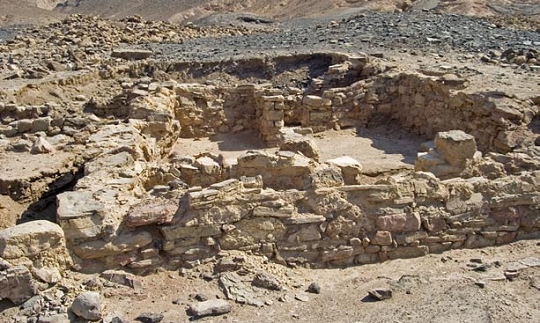 This article was first published in the Fall 2005 issue of Bible and Spade.
This article was first published in the Fall 2005 issue of Bible and Spade.
This story is one that has been repeated time and again throughout more than a century of excavations in the Holy Land. It involves a tendency to make claims based upon incomplete evidence and fails to account for the principle that absence of evidence does not equal evidence of absence. ABR members are well aware of this practice with respect to the Exodus of the Israelites from Egypt under Moses. Scholars belonging to the group of so-called “Minimalists” have become famous (or infamous!) for just this reason, namely, for their skepticism toward the Biblical narrative, often despite the discovery of archaeological evidence corroborating those accounts.
One point of controversy begins with the rather laconic statement in Genesis 36:31 (repeated in 1 Chronicles 1:43) concerning the Kingdom of Edom, whose kings reigned in the land of Edom before any king reigned over the sons of Israel. This did not attract much notice until surveys and excavations in modern Jordan began to tell a different story, one apparently at odds with the Biblical text. If this Biblical statement were true, then the kings of Edom would have necessarily antedated Saul, Israel’s first king, who ruled in the 11th century BC. The problem herein lay with the fact that no excavated site produced material consistent with state formation in the area formerly known as Edom.
Scholars have since taken it as an article of faith that this verse has been refuted by archaeological research. The authoritative Anchor Bible Dictionary (1992) under the entry for Edom says, “Edom was probably not a political unity” in Moses’ time, and for three or four centuries afterward, which also ruled out war with David as recorded in 2 Samuel 8:13–14 and 1 Kings 11:15–16. The preliminary findings of research were now responsible for discrediting several hundred years of Tranjordanian history as recorded in the Old Testament.
These broad conclusive statements were not limited to Bible encyclopedias. None other than Israel Finkelstein of Tel Aviv University contends in his recent book The Bible Unearthed (2001; co-authored with Neil Silberman) that archaeology has made it clear there were no real kings and no state in Edom before the eighth century BC because earlier large settlements and fortresses were lacking. Notice Finkelstein’s reliance on negative (absence of) evidence in arriving at his conclusion.
University of Arizona archaeologist William Dever states in Who Were the Early Israelites and Where Did They Come From? (2003) that the region of Edom remained largely nomadic until perhaps the seventh century, when a semi-sedentary tribal state emerged. Were there any definitive discoveries that led to this conclusion? Was it based on a thorough investigation of every site in Biblical Edom? Unfortunately, the answer to both questions is a resounding no. Some of the most esteemed figures in modern Syro- Palestinian archaeology fell prey to the old logical fallacy in their haste to make bold pronouncements in contradiction to the Bible.
Recent discoveries in the Wadi Faynan, however, have now turned the consensus concerning state formation in Edom upside down. The area was long exploited by the Egyptians, among others, for its rich copper ore deposits. But after the retreat of Egyptian hegemony, the region was left to the devices of the local inhabitants. This seems to be the reason behind the development of Khirbet en-Nahas, a copper-smelting site in the Arabah Valley south of the Dead Sea.
Here a 24-acre site is being excavated that includes numerous mounds of slag, evidence of a large-scale industry that persisted for several centuries, presumably under Edomite supervision. It also includes an Iron Age fortress measuring 73x73 m (239x239 ft) that Nelson Glueck long ago (1940) dated to the 11th century. Carbonized fragments of wood from tamarisk trees found underneath the earliest level of the fortress gate yielded dates in the 12th century that place the construction itself to the tenth century. A four-room building elsewhere at the site yielded a date as early as the 13th century.
The evidence for early occupation is not limited to carbon dates. A variety of dateable artifacts included two scarabs. One depicts a walking sphinx that finds its closest parallel in New Kingdom Egypt of the first half of the 12th century. A second scarab bearing a chariot scene with an archer and a horse belongs to the period from the 12th to the tenth century. However, given the ancient usage of such artifacts, often as amulets or keepsakes, they should be used with caution. They provide a date after which occupation can be dated, though precisely how much later is uncertain.
 |
Four room house at the Edomite site of Kh. En-Nahas dating as early as the 13th century BC. This and other findings at Kh. En-Nahas demonstrate that Edom was an organized political entity prior to the formation of the United Monarch of Israel, as stated in Genesis 36:31 and 1 Chronicles 1:43. Author Janeway points out that scholars’ previous skepticism of these passages was based on negative (lack of) evidence, rather than tangible data.
Most of the pottery can be dated to the early Iron Age II period (tenth–ninth century). There are also forms indicative of earlier periods, including locally made hole-mouth jars known as Negebite Ware. A number of imported pieces include Midianite Ware and Cypro Phoenician Black-on-Red Ware, the former of which was produced as early as the 14th century. The terminal phase of Midianite Ware is not yet firmly established, so conclusive dating of these vessels is not possible, but the assemblage represents a period very early in the Iron I Age.
These multiple lines of evidence—the pottery, dateable objects, and carbon dates, all combine to suggest that a high level of organization existed in the region much earlier than traditionally believed, at a time quite possibly before the rise of monarchies in the neighboring areas of Moab, Ammon, and Judah.
The absence of such evidence until recently should not have foreclosed the possibility of such discoveries being made at some future time. Not all the sites in Edom had or have been subjected to excavation. It underlines the need to temper the conclusions drawn from the absence of archaeological data, particularly in an area as little understood as Biblical Edom. With the new findings from Khirbet en-Nahas, we can once again assert that absence of evidence is most definitely not indicative of evidence of absence, wisdom that archaeologists would be well advised to observe in the future.
Recommended Resources for Further Study
Bibliography
Dever, William G.
2003 Who Were the Early Israelites and Where Did They Come From? Grand Rapids MI: Eerdmans.
Finkelstein, Israel; Silberman, Neil A.
2001 The Bible Unearthed. New York: Free Press.
Levy, T., et al.
2004 Reassessing the Chronology of Biblical Edom: New Excavations and 14C Dates from Khirbet en-Nahas (Jordan). Antiquity 78.302: 865–79.
Valpy, M.
2005 Artifacts from Iron Age Fortress Confirm Old Testament Dates of Edomite Kingdom. Toronto Globe and Mail, January 25.